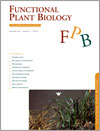
Functional Plant Biology
Volume 40 Number 4 2013
FP12321The evolution of desiccation tolerance in angiosperm plants: a rare yet common phenomenon
Many seeds can survive long periods in dormant airdry state before rehydration elicits germination. Leaves generally do not; except in ‘resurrection plants’, dry foliage also can revive. The basic mechanism of desiccation tolerance in resurrection plants stems from the earliest-evolved photosynthetic organisms. However, the regulation of its expression varies among angiosperm families. Future work to produce crop plants with desiccation-tolerant foliage should heed the probability of family-specificity in the regulation of the expression of seed-type desiccation tolerance.
FP12242TaPht1;4, a high-affinity phosphate transporter gene in wheat (Triticum aestivum), plays an important role in plant phosphate acquisition under phosphorus deprivation
Phosphorus is transported into and within plants mainly via phosphate transporters (PTs) coupled to the proton gradient. The high-affinity wheat PT gene TaPht1;4 is specifically detected in roots and highly induced under Pi deficiency and can improve Pi acquisition in yeast and wheat under low-Pi conditions. TaPht1;4 broadens our understanding of the PT functions in wheat as well as in other higher plants.
FP12269Grain, sugar and biomass accumulation in tropical sorghums. I. Trade-offs and effects of phenological plasticity
Based on a field study on 14 genotypes with three sowing dates, this paper demonstrates that physiological trade-offs among biomass, grain and sugar production are small in late-maturing and photoperiod-sensitive sweet sorghums. These results provide novel insights for the phenotyping and ideotyping of pluripurpose sorghum, and highlight the opportunity offered by tropical sorghum’s genetic diversity. Further research is needed on the interactions of these traits with agricultural practices and drought.
FP12177Grain, sugar and biomass accumulation in photoperiod-sensitive sorghums. II. Biochemical processes at internode level and interaction with phenology
Sorghum can produce grains while accumulating sugar and biomass, particularly in long-cycle photoperiodic genotypes. The study explores the physiological tradeoffs between such combined productions according to photoperiod effect on plant phenology. It demonstrates that the sucrose storage physiology of sorghum is similar to sugarcane and that long-cycle duration can minimise competition and optimise the combination of grain, sugar and biomass production.
FP12182Identification and genes expression analysis of ATP-dependent phosphofructokinase family members among three Saccharum species
Sugarcane is the primary sugar crop, but the evolution and regulation of sucrose metabolism are not fully understood. We characterized the ATP-dependent phosphofructokinase (PFK) gene family in sugarcane and analyzed the phylogenetic relationship and gene expression patterns of PFK family members. Our findings provided fundamental information for elucidating the role of particular PFK family members in the speciation and domestication of sugarcane as a highly productive and efficient sugar crop.
FP12270Temporal and spatial patterns of soil water extraction and drought resistance among genotypes of a perennial C4 grass
Climate change is likely to bring extended periods of dry weather. The objective of this study was to investigate patterns of soil water extraction and drought resistance among different Australian turfgrasses and we showed the most drought resistant grasses were those that extracted more water from the soil profile. We are not sure how the resistant grasses extracted more water but resistance was not associated with greater rooting depth.
FP12257Function of leafy sepals in Paris polyphylla: photosynthate allocation and partitioning to the fruit and rhizome
Over harvesting Paris polyphylla due to increased demand for its medicinal rhizome has been widely observed. We found the green sepals of Paris polyphylla function partly as leaves in producing photosynthates, which is differentially partitioned to fruit and rhizome. Fruit removal leading to improved rhizome yield and quality prompted the use of a farming practice in favour of the sustainable supply and conservation of Paris polyphylla.
FP12204The anatomical basis of the link between density and mechanical strength in mangrove branches
The survival, growth and the degree of coastal protection offered by mangrove branches during extreme events like cyclones and tsunamis are dependent on their density and mechanical strength. We found that mangrove species with greater mechanical strength of branches tended to have smaller xylem vessel lumen areas and for Avicennia marina had less phloem in their wood. Species with branches of higher density and mechanical strength (Avicennia marina, Aegiceras corniculatum and Ceriops australis) are likely to be less vulnerable to damage than Rhizophora stylosa and Bruguiera gymnorrhiza and may survive and maintain coastal protection after cyclones.
FP12208Spectral assessments of wheat plants grown in pots and containers under saline conditions
Scientists are searching for quick phenotyping methods for timely recognition of the impacts caused by salinity. Salinity-related traits of pot- and container-grown wheat plants were evaluated by active and passive sensing. Traits could be identified better in container-grown plants reflecting a closer-to-field situation. The potential and limitations of greenhouse studies to scale up to conventional field conditions needs to be further investigated.



